PhotonLabeler: An Inter-Disciplinary Platform for Visual Interpretation and Labeling of ICESat-2 Geolocated Photon Data
Abstract
1. Introduction
2. Materials and Methods
2.1. ATL03 Data
2.1.1. Data Description and Organization
2.1.2. Visualizing and Interpreting ATL03 Data
2.2. PhotonLabeler User Interface (UI) and Software Capabilities
2.2.1. UI Layout Overview and Display Control
2.2.2. Reading and Visualization of ATL03 Data in PhotonLabeler
2.2.3. Creating a Point Label Definition, Selecting, and Labeling Points
2.2.4. Exporting Labeled Data, Saving, and Loading Labeling Sessions
2.2.5. Software Availability
2.3. Case study: Using Manually Labeled Data to Access Accuracy of ATL08 Data
2.3.1. ATL08 Product Overview
2.3.2. Study Sites and Objective
2.3.3. Data and Labeling
2.3.4. Preparing Height Metrics and Photon Classification Data
2.3.5. Comparing ATL08 and PhotonLabeler Derived Height Metrics and Photon Classification Data
3. Results
3.1. Photon Labeling
3.2. ATL08 Photon Classification Comparison Results
3.3. ATL08 Height Metric Comparison Results
4. Discussion
5. Conclusions
Supplementary Materials
Author Contributions
Funding
Acknowledgments
Conflicts of Interest
References
- Markus, T.; Neumann, T.; Martino, A.; Abdalati, W.; Brunt, K.; Csatho, B.; Farrell, S.; Fricker, H.; Gardner, A.; Harding, D.; et al. The ice, cloud, and land elevation satellite-2 (ICESat-2): Science requirements, concept, and implementation. Remote Sens. Environ. 2017, 190, 260–273. [Google Scholar] [CrossRef]
- Popescu, S.C.; Zhou, T.; Nelson, R.; Neuenschwander, A.; Sheridan, R.; Narine, L.; Walsh, K.M. Photon counting lidar: An adaptive ground and canopy height retrieval algorithm for ICESat-2 data. Remote Sens. Environ. 2018, 208, 154–170. [Google Scholar] [CrossRef]
- Petty, A.A.; Kurtz, N.T.; Kwok, R.; Markus, T.; Neumann, T.A. Winter arctic sea ice thickness from ICESat-2 freeboards. J. Geophys. Res. Oceans 2020, 125, e2019JC015764. [Google Scholar] [CrossRef]
- Smith, B.; Fricker, H.A.; Gardner, A.S.; Medley, B.; Nilsson, J.; Paolo, F.S.; Holschuh, N.; Adusumilli, S.; Brunt, K.; Csatho, B.; et al. Pervasive ice sheet mass loss reflects competing ocean and atmosphere processes. Science 2020, 368, 1239–1242. [Google Scholar] [CrossRef] [PubMed]
- Neuenschwander, A.L.; Magruder, L.A. Canopy and terrain height retrievals with ICESat-2: A first look. Remote Sens. Basel 2019, 11, 1721. [Google Scholar] [CrossRef]
- Narine, L.L.; Popescu, S.C.; Malambo, L. Using ICESat-2 to estimate and map forest aboveground biomass: A first example. Remote Sens. Basel 2020, 12, 1824. [Google Scholar] [CrossRef]
- Zhang, G.; Chen, W.; Xie, H. Tibetan plateau’s lake level and volume changes from NASA’s ICESat/ICESat-2 and Landsat missions. Geophys. Res. Lett. 2019, 46, 13107–13118. [Google Scholar] [CrossRef]
- Harding, D.J.; Dabney, P.W.; Valett, S. Polarimetric, Two-Color, Photon-Counting Laser Altimeter Measurements of Forest Canopy Structure; International Symposium on Lidar and Radar Mapping 2011: Technologies and Applications, 2011; International Society for Optics and Photonics: Bellingham, WA, USA, 2011; p. 828629. [Google Scholar]
- Neumann, T.; Brenner, A.; Hancock, D.; Robbins, J.; Saba, J.; Harbeck, K.; Gibbons, A. Ice, Cloud, and Land Elevation Satellite–2 (ICESat-2) Project: Algorithm Theoretical Basis Document (ATBD) for Global Geolocated Photons (ATL03); National Aeronautics and Space Administration, Goddard Space Flight Center: Greenbelt, MD, USA, 2019. Available online: https://escholarship.org/uc/item/0xv7b6br#main (accessed on 24 September 2020).
- Swatantran, A.; Tang, H.; Barrett, T.; DeCola, P.; Dubayah, R. Rapid, high-resolution forest structure and terrain mapping over large areas using single photon lidar. Sci. Rep. UK 2016, 6, 28277. [Google Scholar] [CrossRef] [PubMed]
- Parrish, C.E.; Magruder, L.A.; Neuenschwander, A.L.; Forfinski-Sarkozi, N.; Alonzo, M.; Jasinski, M. Validation of ICESat-2 ATLAS bathymetry and analysis of atlas’s bathymetric mapping performance. Remote Sens. Basel 2019, 11, 1634. [Google Scholar] [CrossRef]
- Wang, C.; Zhu, X.; Nie, S.; Xi, X.; Li, D.; Zheng, W.; Chen, S. Ground elevation accuracy verification of ICESat-2 data: A case study in Alaska, USA. Opt. Express 2019, 27, 38168–38179. [Google Scholar] [CrossRef] [PubMed]
- Malambo, L.; Heatwole, C.D. Automated training sample definition for seasonal burned area mapping. ISPRS J. Photogramm. Remote Sens. 2020, 160, 107–123. [Google Scholar] [CrossRef]
- Kennedy, R.E.; Cohen, W.B.; Schroeder, T.A. Trajectory-based change detection for automated characterization of forest disturbance dynamics. Remote Sens. Environ. 2007, 110, 370–386. [Google Scholar] [CrossRef]
- Malambo, L.; Popescu, S.C.; Horne, D.W.; Pugh, N.A.; Rooney, W.L. Automated detection and measurement of individual sorghum panicles using density-based clustering of terrestrial lidar data. ISPRS J. Photogramm. Remote Sens. 2019, 149, 1–13. [Google Scholar] [CrossRef]
- Neuenschwander, A.; Popescu, S.; Nelson, R.; Harding, D.; Pitts, K.; Robbins, J.; Pederson, D.; Sheridan, R. Ice, Cloud, and Land Elevation 1 Satellite 2 (ICESat-2) Algorithm Theoretical Basis Document (ATBD) for Land-Vegetation Along-Track Products (ATL08) Release 002; National Aeronautics and Space Administration, Goddard Space Flight Centre: Greenbelt, MD, USA, 2019. Available online: https://icesat-2.gsfc.nasa.gov/sites/default/files/page_files/ICESat2_ATL08_ATBD_r002_v2.pdf (accessed on 24 September 2020).
- Neuenschwander, A.; Pitts, K. The ATL08 land and vegetation product for the ICESat-2 mission. Remote Sens. Environ. 2019, 221, 247–259. [Google Scholar] [CrossRef]
- Hansen, M.C.; Potapov, P.V.; Goetz, S.J.; Turubanova, S.; Tyukavina, A.; Krylov, A.; Kommareddy, A.; Egorov, A. Mapping tree height distributions in sub-saharan Africa using Landsat 7 and 8 data. Remote Sens. Environ. 2016, 185, 221–232. [Google Scholar] [CrossRef]
- Liu, C.; Neal, J.; Scofield, C.; Chang, J.; Ludeke, A.K.; Frentress, C. Classification of Land Cover and Assessment of Forested Wetlands in the Cypress Creek Watershed; Texas Parks and Wildlife Department: Austin, TX, USA, 1996; 21p.
- Isenburg, M. Lastools: Efficient Tools for Lidar Processing. Available online: https://rapidlasso.com/lastools/ (accessed on 15 January 2020).
- Chidumayo, E. Climate and phenology of savanna vegetation in southern Africa. J. Veg. Sci. 2001, 347–354. [Google Scholar] [CrossRef]
- Hill, M.J.; Millington, A.; Lemons, R.; New, C. Functional phenology of a Texas post oak savanna from a chris proba time series. Remote Sens. Basel 2019, 11, 2388. [Google Scholar] [CrossRef]
- Malambo, L.; Popescu, S.; Ku, N.-W.; Rooney, W.; Zhou, T.; Moore, S. A deep learning semantic segmentation-based approach for field-level sorghum panicle counting. Remote Sens. Basel 2019, 11, 2939. [Google Scholar] [CrossRef]
- Narine, L.L.; Popescu, S.C.; Malambo, L. Synergy of ICESat-2 and Landsat for mapping forest aboveground biomass with deep learning. Remote Sens. Basel 2019, 11, 1503. [Google Scholar] [CrossRef]
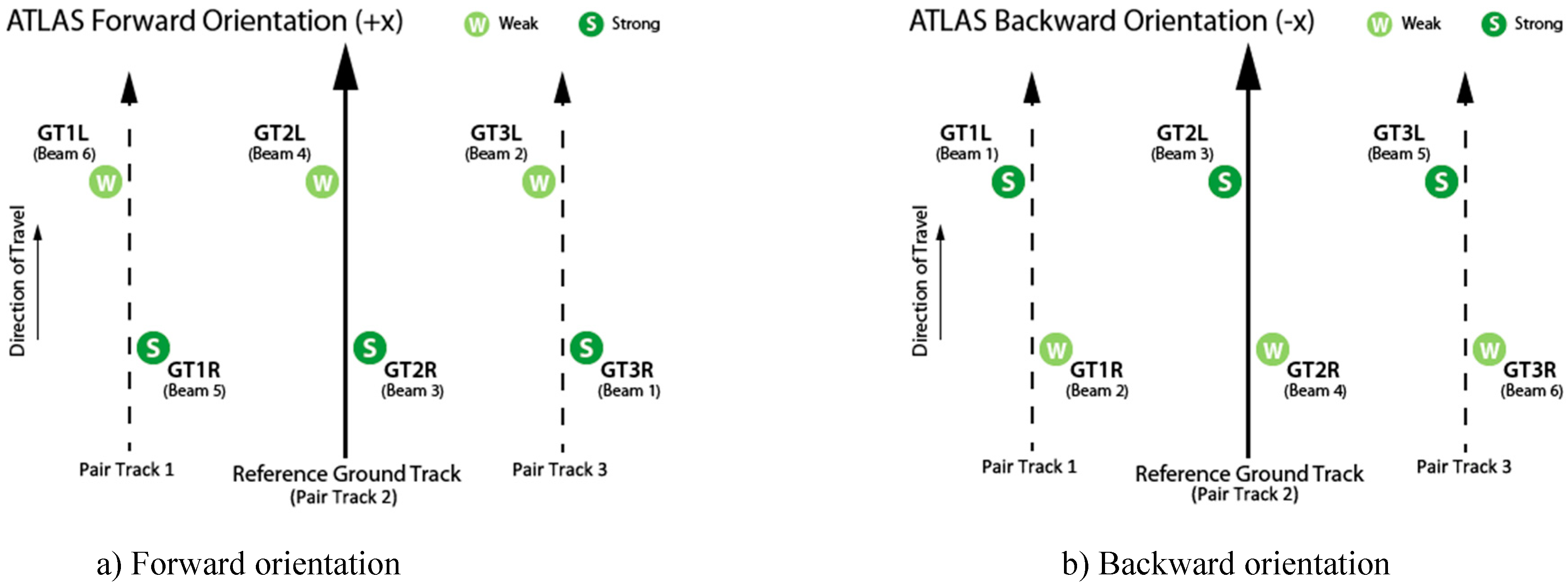
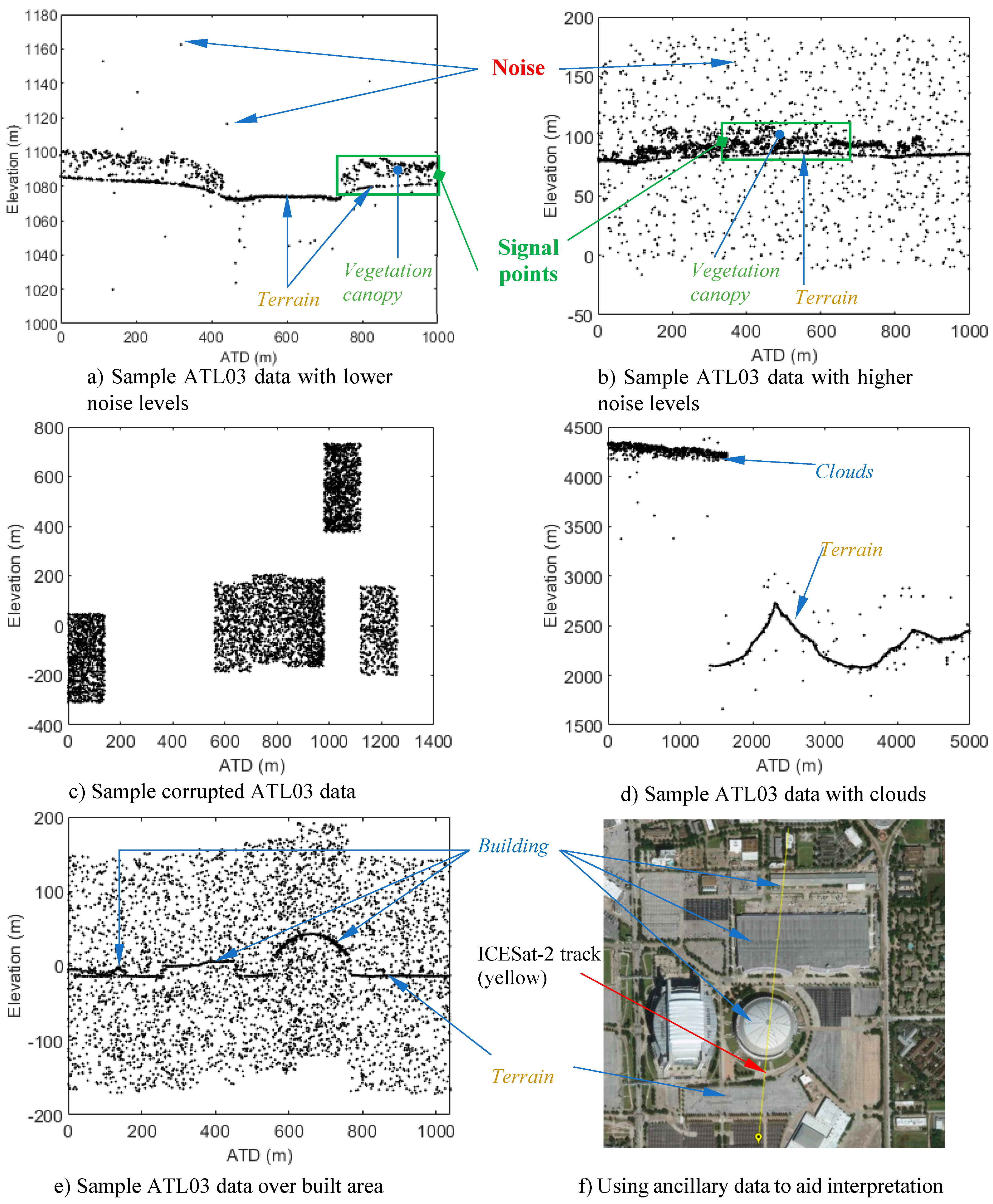
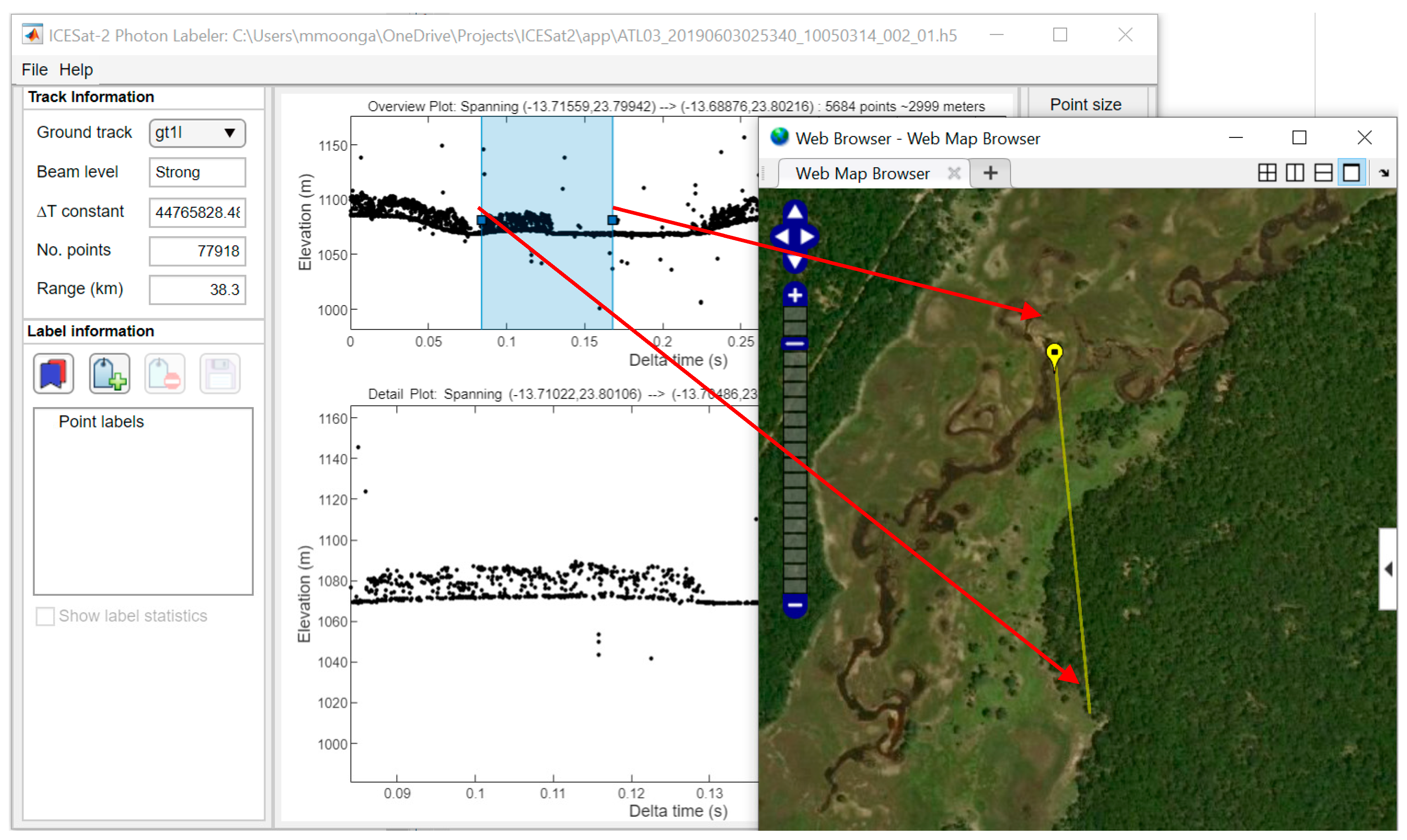

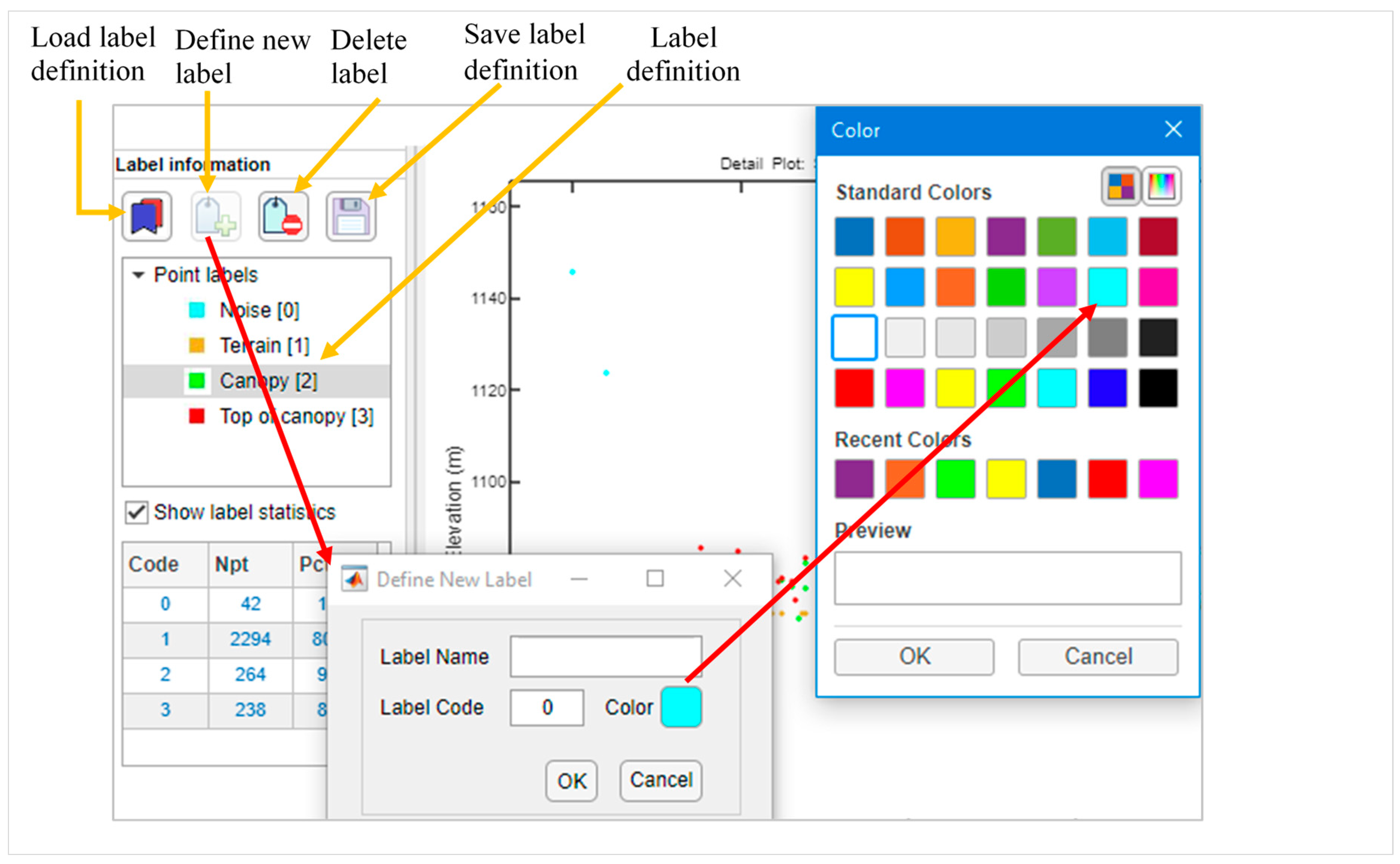
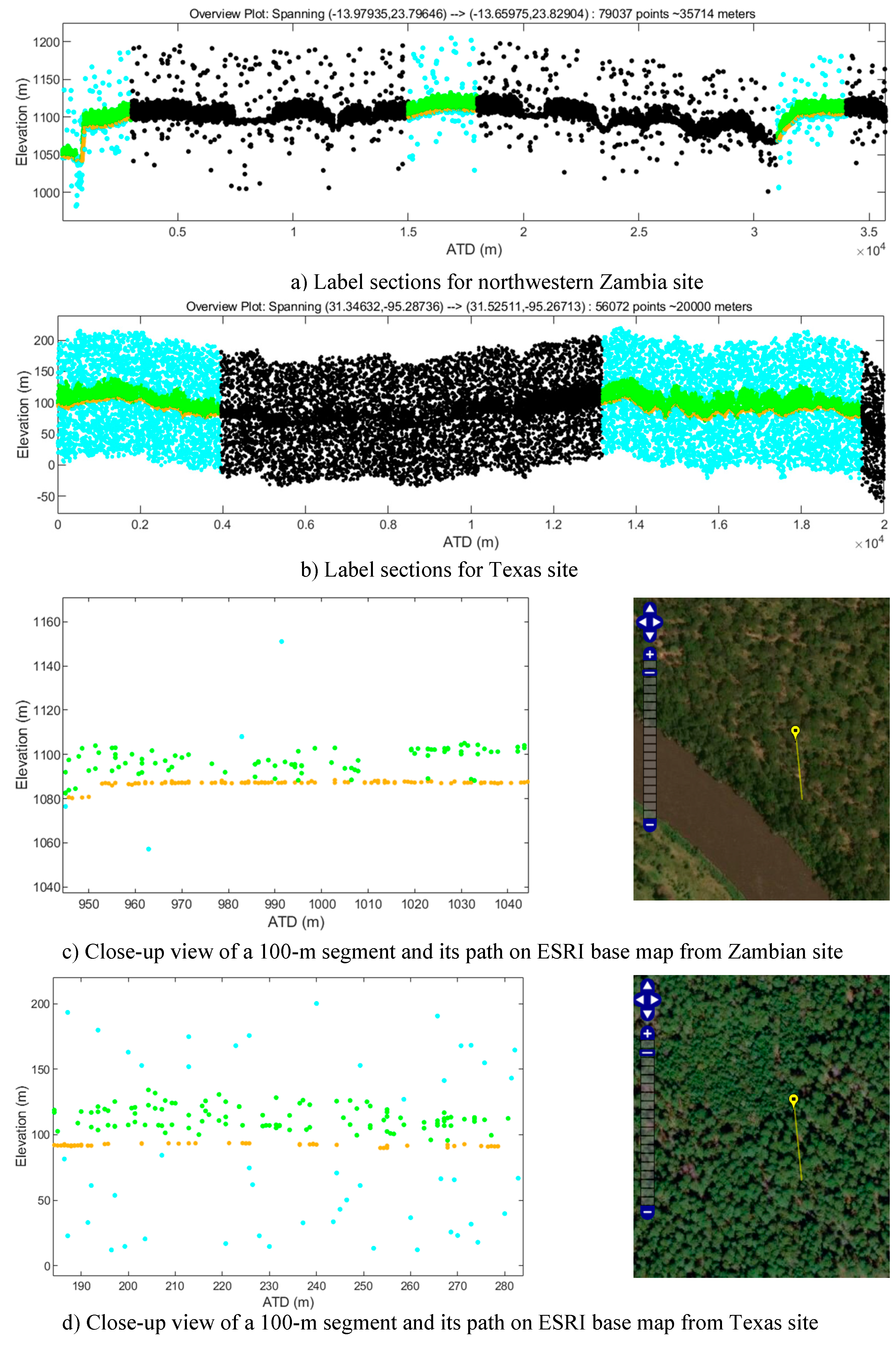
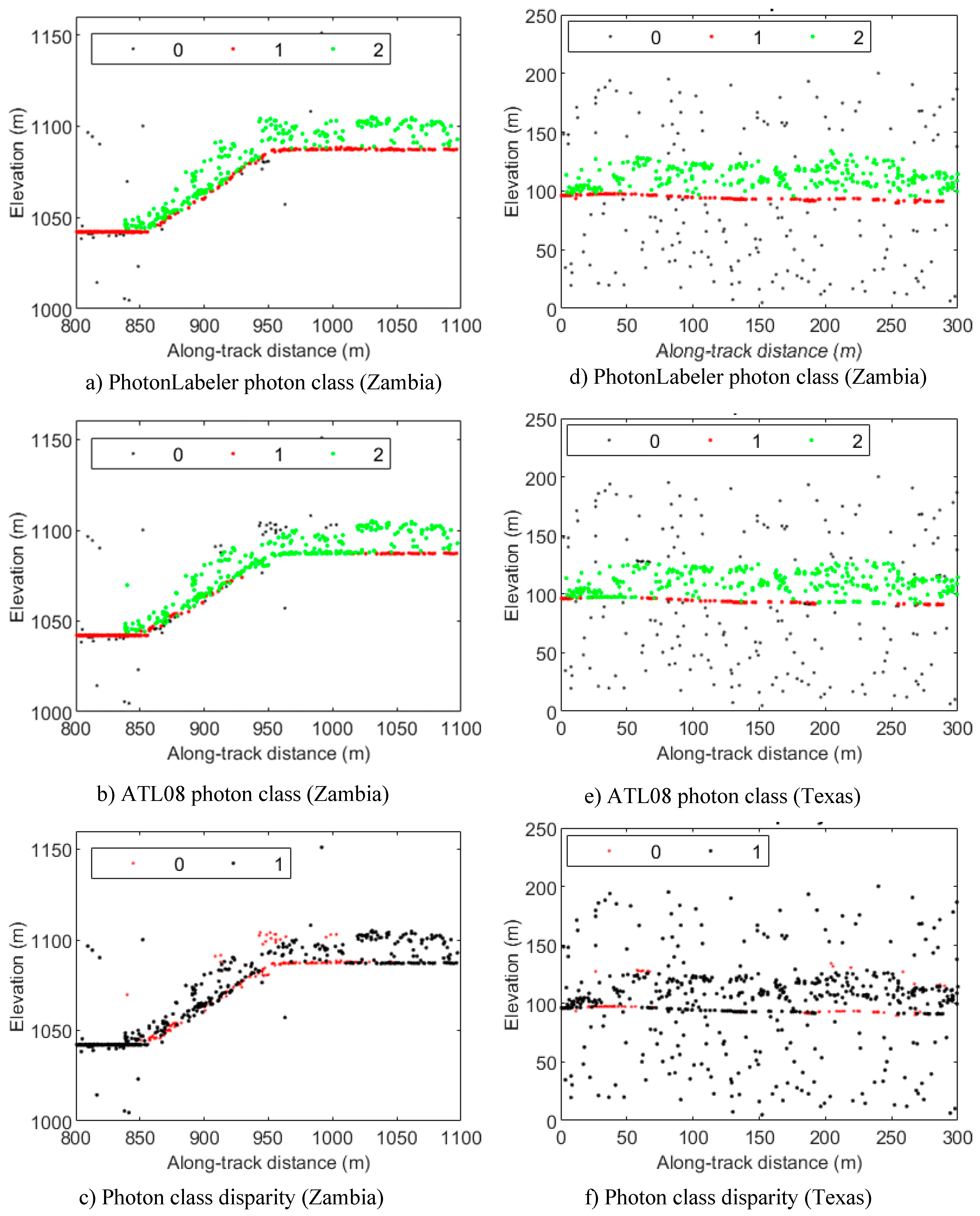
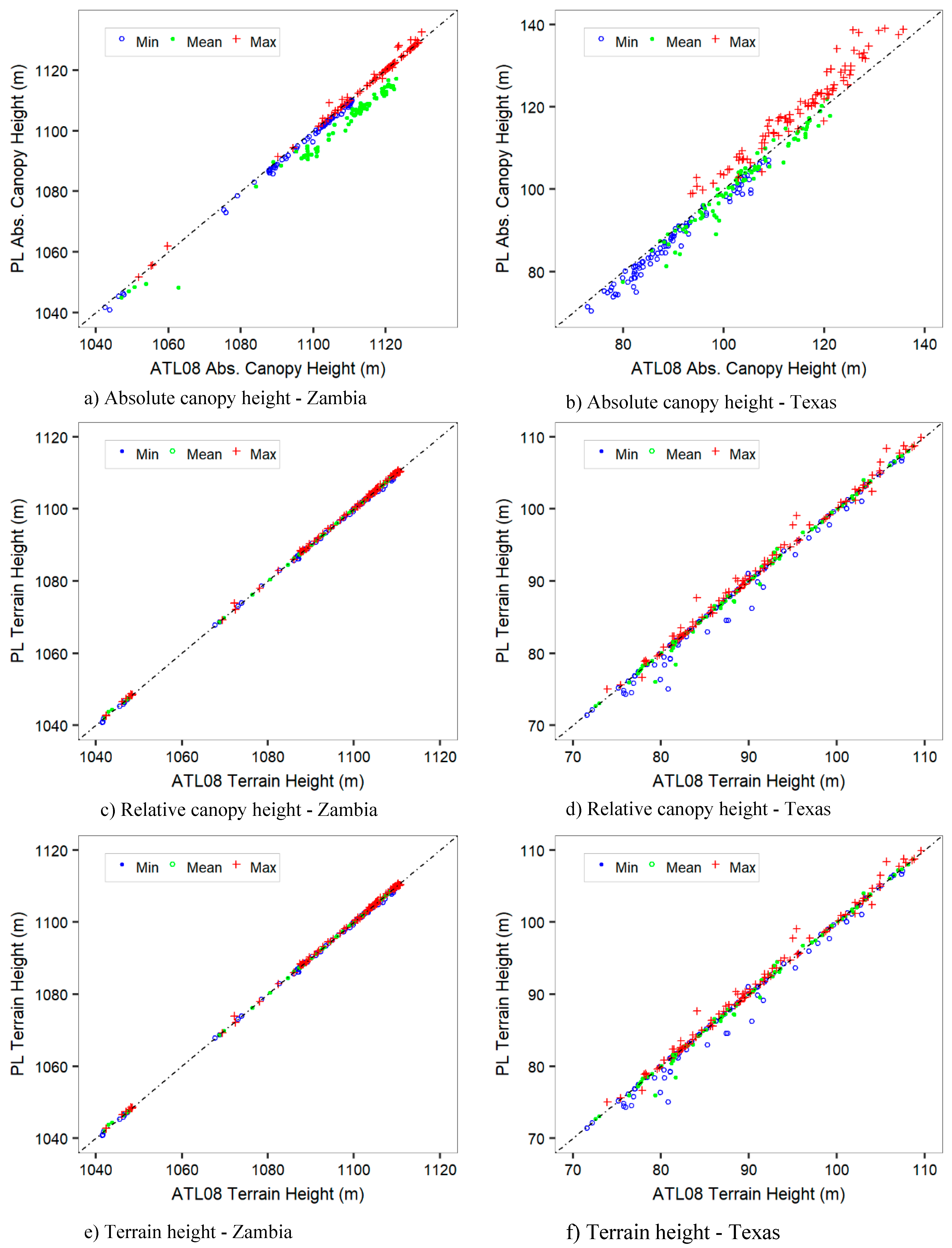
| Metric | Max | Mean | Min | P25 | P50 | P60 | P70 | P75 | P80 | P85 | P90 | P95 |
|---|---|---|---|---|---|---|---|---|---|---|---|---|
| Absolute canopy height | x | x | x | x | x | x | x | x | x | x | x | x |
| Relative canopy height | x | x | x | x | x | x | x | x | x | x | x | x |
| Terrain height | x | x | x |
| Northwestern Zambia | Eastern Texas, USA | ||||
|---|---|---|---|---|---|
| Label | Label Code | No. Points | Proportion (%) | No. Points | Proportion (%) |
| Noise | 0 | 695 | 3.2 | 7355 | 31.1 |
| Terrain | 1 | 13,843 | 63.7 | 3306 | 14.0 |
| Off-terrain | 2 | 7201 | 33.1 | 13,026 | 55.0 |
| Total | 21,739 | 100 | 23,687 | 100.0 | |
| PhotonLabeler | Error (%) | ||||||
|---|---|---|---|---|---|---|---|
| Labels | Noise | Terrain | Off-Terrain | Total | Commission | Omission | |
| ATL08 | Noise | 380 | 22 | 9 | 411 | 7.5 | 45.3 |
| Terrain | 215 | 13,693 | 531 | 14,439 | 5.2 | 1.1 | |
| Off-terrain | 100 | 128 | 6661 | 6889 | 3.3 | 7.5 | |
| Total | 695 | 13,843 | 7201 | 21,739 | |||
| PhotonLabeler | Error (%) | ||||||
|---|---|---|---|---|---|---|---|
| Labels | Noise | Terrain | Off-Terrain | Total | Commission | Omission | |
| ATL08 | Noise | 6450 | 0 | 83 | 6533 | 1.3 | 12.3 |
| Terrain | 644 | 3248 | 549 | 4441 | 26.9 | 1.8 | |
| Off-terrain | 261 | 58 | 12,394 | 12,713 | 2.5 | 4.9 | |
| Total | 7355 | 3306 | 13,026 | 23,687 | |||
| Absolute Canopy Height | Relative Canopy Height | Terrain Height | ||||
|---|---|---|---|---|---|---|
| Metric | Texas | Zambia | Texas | Zambia | Texas | Zambia |
| Max | 0.94 | 1.00 | 0.82 | 0.60 | 0.99 | 1.00 |
| Mean | 0.96 | 0.99 | 0.82 | 0.82 | 1.00 | 1.00 |
| Min | 0.98 | 1.00 | 0.29 | 0.00 | 0.99 | 1.00 |
| P25 | 0.87 | 0.98 | 0.57 | 0.67 | ||
| P50 | 0.89 | 0.95 | 0.62 | 0.86 | ||
| P60 | 0.90 | 0.94 | 0.71 | 0.79 | ||
| P70 | 0.94 | 0.92 | 0.75 | 0.73 | ||
| P75 | 0.96 | 0.93 | 0.79 | 0.78 | ||
| P80 | 0.97 | 0.95 | 0.85 | 0.78 | ||
| P85 | 0.98 | 0.97 | 0.84 | 0.79 | ||
| P90 | 0.97 | 0.99 | 0.87 | 0.80 | ||
| P95 | 0.97 | 0.99 | 0.89 | 0.76 | ||
| Absolute Canopy Height | Relative Canopy Height | Terrain Height | ||||
|---|---|---|---|---|---|---|
| Metric | Texas | Zambia | Texas | Zambia | Texas | Zambia |
| Max | 4.29 | 0.35 | 4.63 | −0.17 | 0.45 | 0.19 |
| Mean | −1.51 | −5.89 | 2.91 | 0.26 | −0.08 | 0.02 |
| Min | −2.39 | −1.31 | 0.48 | 0.18 | −0.61 | −0.21 |
| P25 | −5.13 | −6.36 | 3.14 | 0.70 | ||
| P50 | −1.76 | −9.63 | 3.27 | 0.14 | ||
| P60 | −0.61 | −9.76 | 3.16 | 0.03 | ||
| P70 | 0.39 | −7.89 | 3.00 | −0.02 | ||
| P75 | 0.90 | −6.44 | 3.00 | −0.10 | ||
| P80 | 1.47 | −4.93 | 3.02 | −0.25 | ||
| P85 | 1.83 | −3.31 | 3.12 | −0.33 | ||
| P90 | 2.33 | −2.14 | 3.19 | −0.36 | ||
| P95 | 2.69 | −1.33 | 3.36 | −0.34 | ||
© 2020 by the authors. Licensee MDPI, Basel, Switzerland. This article is an open access article distributed under the terms and conditions of the Creative Commons Attribution (CC BY) license (http://creativecommons.org/licenses/by/4.0/).
Share and Cite
Malambo, L.; Popescu, S. PhotonLabeler: An Inter-Disciplinary Platform for Visual Interpretation and Labeling of ICESat-2 Geolocated Photon Data. Remote Sens. 2020, 12, 3168. https://doi.org/10.3390/rs12193168
Malambo L, Popescu S. PhotonLabeler: An Inter-Disciplinary Platform for Visual Interpretation and Labeling of ICESat-2 Geolocated Photon Data. Remote Sensing. 2020; 12(19):3168. https://doi.org/10.3390/rs12193168
Chicago/Turabian StyleMalambo, Lonesome, and Sorin Popescu. 2020. "PhotonLabeler: An Inter-Disciplinary Platform for Visual Interpretation and Labeling of ICESat-2 Geolocated Photon Data" Remote Sensing 12, no. 19: 3168. https://doi.org/10.3390/rs12193168
APA StyleMalambo, L., & Popescu, S. (2020). PhotonLabeler: An Inter-Disciplinary Platform for Visual Interpretation and Labeling of ICESat-2 Geolocated Photon Data. Remote Sensing, 12(19), 3168. https://doi.org/10.3390/rs12193168







